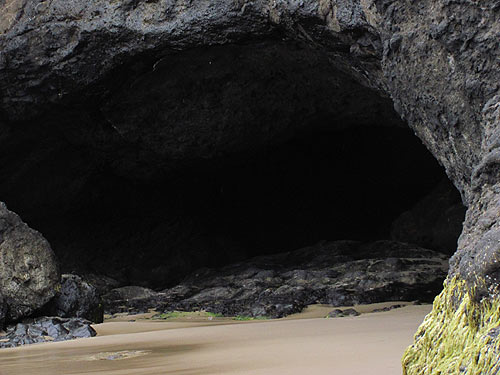Cool Caves, Cajoling Caverns of the Oregon Coast
Published 02/09/2013

(Oregon Coast) – If you want to do any real exploring at all – and not just hit the most populated beaches that lay in the middle of any coastal town – this is where the true treasures are found. Some of the best pleasures of the coastline are not in the sand at all, but in the rocky cliffs that tower over the sands. (Above: Inside the bigger cave at Bob Creek)
In these places, you may find the awe-inspiring caves – the semi-secretive cubbyholes of basalt that inspire the imagination and fire up immediate curiosity. Here are a few places you'll find them:

At Bob Creek Wayside, south of Yachats, more tide pools than humans populate this obscure but fascinating place. They really emerge at lower tides, clinging to odd, mushroom-shaped rocky blobs at the southern end.
At this end, there's also a series of sea caves. First, you'll encounter a small one next to a huge boulder that creates a sort of arch by leaning up against the cliff. On the other side of the arch, there's a sizable sea cave that allows you to walk inside and check out the freaky debris deposited there by the tides. Water is dripping from the top and it gets a little dark, so watch the slippery stuff. You probably don't want to amble around the weird shapes at the very end of the cave, because things can get dangerous.

Just a few miles north of Bob Creek, you'll find Neptune State Park. It's a pretty place, lodged in the middle of forestland and rather easy to drive past if you're not looking carefully. There are picnic tables, restrooms and a sandy beach that changes into a series of craggy, rock landmasses. Continue walking north, over the creek, and you'll bump into a funky little sea cave on the bend going around to the beach that wanders northward.

Inside the cave
This cave is interesting geologically, apparently a little puzzling to experts. It's clearly mostly basalt – once lava that came pouring out here millions and millions of years ago, most likely from around Cape Perpetua. But it has an odd red to it.
Seaside geologist Tom Horning said this reddish color could come from either a lot of iron in the mix or from whatever else comprises this mix of basalt and other rocks. That iron or other material then weathered and became red.

Along the Three Capes Tour, west of Tillamook, sits the tiny town of Oceanside. There, you'll find not a natural cave but a manmade tunnel leading through the headland to a wondrous hidden spot. These days, Oceanside seems to have wound up back on the radar of tourists, so it's exactly hidden anymore. But go through that concrete structure and there are other sea caves to explore - big and small - plus numerous interesting rocky slabs to play around and copious beachcombing possibilities.

Down around Florence, the Heceta Head Lighthouse and Devil's Elbow State Park ooze fun and intrigue in all the ways to explore it. Directly below the lighthouse sits a sizable sea cave you should probably never go to. Perhaps on extreme low tide events it's more accessible.
However, the best you can do is dart out on an out-going wave and take a sneak peek from behind some of the rocks here. Maybe if you're lucky, the tide will even be far enough out to take some brief photos.
Find out more about these areas at the Three Capes: Pacific City, Oceanside Virtual Tour, the Florence Virtual Tour, and the Upper Lane County Virtual Tour.

More About Oregon Coast hotels, lodging.....
More About Oregon Coast Restaurants, Dining.....
LATEST Related Oregon Coast Articles
Likely just before dawn best hour but peak happens during daylight. Weather
Dark Sky Week is Prime Along Oregon Coast: Where and Where Not to Go
General guide to dark sky viewing from south to north coast. Astronomy
Sizable Price Drop, Deals in Lincoln City During Quiet of April on Central Or...
20 perc off at A1 Vacation Rentals across its roster, including Gleneden Beach. Lincoln City specials
Upcoming S. Oregon Coast Events Include Gem Show, History: Coos Bay, Bandon
May 6 talk at Coos History Museum, Mayfly Fest May 17, Bandon Rock / Gem Show June 7,8
Washington Coast Cleanup on April 19 - Coinciding with Oregon Coast's SOLVE E...
From the Puget Sound to Long Beach, alongside Oregon's cleanup. Washington coast events, Seaside events
Astoria's Riverwalk Gets New Lighting, More N. Oregon Coast Roadwork
Delays coming this summer, but the riverwalk has a new look. Seaside, Cannn Beach
April Gets Even Cheaper Midweek at Depoe Bay, Lincoln City: Oregon Coast Deals
Off-season rates plus more at Keystone Vacation Rentals. Depoe Bay lodging specials, Lincoln City hotel reviews, Newport hotel reviews
Washington Coast Begins Week of Clam Digs, April 12 Through 18
Long Beach, Twin Harbors, Mocrocks and Copalis at different times. Washington coast events
Back to Oregon Coast
Contact Advertise on BeachConnection.net
All Content, unless otherwise attributed, copyright BeachConnection.net Unauthorized use or publication is not permitted












































